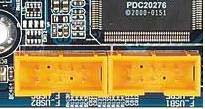 |
| Introduction of USB 2.0
|
 |
USB 2.0 supports PC-centric connection to high speed and high performance PC peripherals with bandwidth of 480Mbps. |
 |
USB acts as the interface for data transfer between platform and peripherals such as keyboard, mouse, joystick, printer, scanner and even other high-speed devices such as external storage, digital cameras, webcams with the newest USB 2.0. |
 |
USB allows expandability of the PC's capabilities via an external port, eliminating the need for users or integrators to open the system chassis. Since USB supports multiple peripheral devices simultaneously, it allows users to run numerous devices such as printers, scanners, digital cameras and speakers from a single PC. |
 |
USB also allows for automatic device detection and installation, making connectivity a true plug-and-play experience for end users. |
|
|
| Why USB 2.0
|
 |
USB 2.0 extends the speed of the connection from 12 Mbps on USB 1.1 up to 480 Mbps on USB 2.0, providing an attachment point for next-generation peripherals which complement higher performance PCs and user applications. |
 |
The higher bandwidth of USB 2.0 will permit PC peripherals with more functionality, including higher resolution video conferencing cameras, next generation scanners and printers, fast storage units, and faster broadband Internet connections. |
|
|
| USB 2.0 and USB 1.1
|
 |
USB 1.1's data rate of 12 Mbps is sufficient for many PC peripherals such as telephones, keyboards, mice, digital joysticks, floppy drives, digital speakers, and low-end printers. |
 |
USB 2.0 is backward compatible with USB 1.1, resulting in a seamless transition process for the end user. Those peripherals work with USB1.1 will continue to operate with no change in USB 2.0 systems. |
 |
Working w/ the existing USB1.1 connectors and cables: USB 2.0 uses the same cables and connectors as USB 1.1. |
|
|
| USB2.0/1.1 Peripheral Devices
|
|
|
|
| GIGABYTE USB 2.0
|
 |
The feature of USB 2.0 is available in GIGABYTE P4 Titan 533 series motherboard and AMD Athlon series motherboard. |
 |
There are two USB ports available on Rear panel of motherboard (as picture.). |
 |
Additional USB ports are provided by on board USB connectors. Cable with rear bracket is available for the connection (as picture.) |
| |
| |

USB ports on rear panel |
| |
| |

Onboard USB 2.0 connectors |
| |
| |

USB ports on rear bracket with Cable |
| |
| |

Connection of rear bracket and connectors on Motherboard |
|
|
2002 GIGA-BYTE TECHNOLOGY CO., LTD. All rights reserved.
|
|